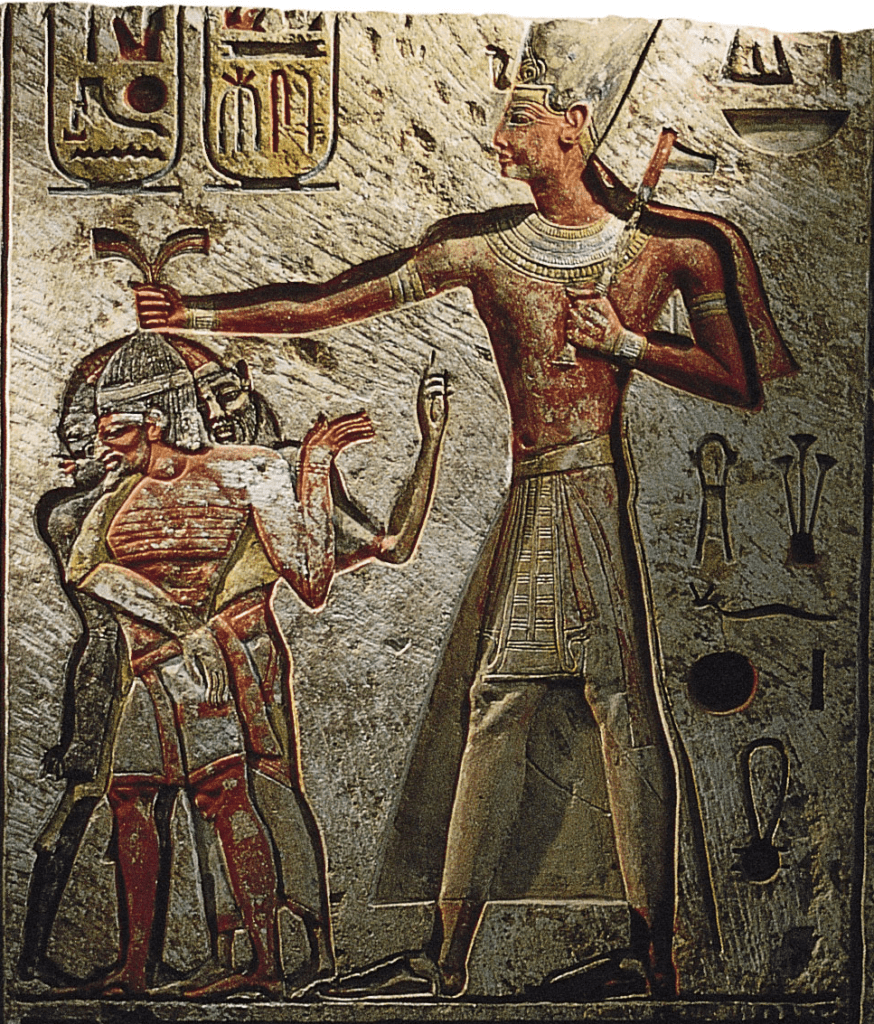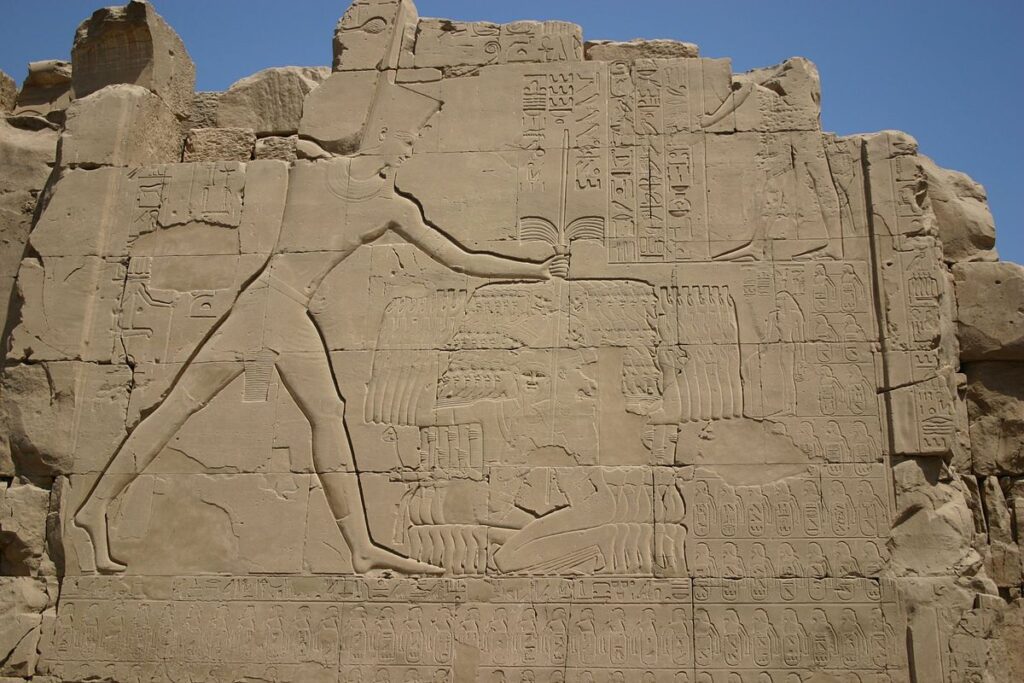The Non-Existent Battles of the Pharaohs – Evidence in Support of the GKS
You may prefer to go straight to my challenge here before reading the following.
The Non-Existent battles of the Egyptian Pharaohs – A Challenge!
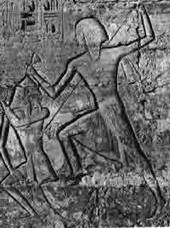
History teaches us that Egypt was a warring nation; a large army was big business. It wasn’t required for defence as the Egyptians did not want peace; peace was not a virtue. It was the role of the pharaoh to lead his army to conquer foreign lands and return home with the spoils of war.
Many battles were recorded for posterity on temple walls and some, such as Ramesses II and the battle of Kadesh, were repeated many times. The sacred inscriptions provided details of the many pharaohs who fearlessly fought off and defeated the enemy, sometimes single-handedly.
“The King himself led the way of the army, mighty at its head, like a flame of fire, the king who wrought with his sword. He went forth, none like him, slaying the barbarians, smiting Retenu, bringing their princes as living captives, their chariots, wrought with gold, bound to their horses.”
(A viceroy of Kush recording Tuthmosis’ exploits)
The battle accounts were accompanied by images of the pharaohs in the act of ‘smiting the enemy.’ The enclosed illustrations are typical of the many recurring scenes which depicted the pharaoh with mace raised ready to vanquish the enemy. Such scenes echoed the mythical conflict between the gods Horus and Seth in the continuing battle of good against evil. This archetypal image can be found in scenes from Egypt through to the fertile-crescent and Anatolia. Some refer to this scene as ‘God with the Upraised Arm.’
FACT: Despite the many hundreds of military expeditions carried out by the pharaohs over a 3,000 period archaeologists have been unable to verify ANY of the events recounted in Egyptian records. This, despite the fact that we know the exact location of many of Egypt’s Pharaonic battles (Megiddo).

The GKS contends that all pharaonic wars, military campaigns and border skirmishes are ALL time honoured accounts of the countless cosmic battles (RHB) undertaken by Mars, Mercury and the Moon (rarely queen Venus) in the guise of divine warrior kings, as they fought and appeared to defeat the masses upon masses of enemy space debris that engulfed our solar system only a few thousand years ago. It was seen as a perennial battle between the forces of good and light (Horus) and the forces of evil and darkness (Seth) as the enemy many times threatened to block out the sun god Ra. This was the very same dust and debris that turned the Sun red for over three millennia. To further appreciate the God King Scenario please click here.
Before we progress, I would like to make something very clear; I’m not for one moment contending the earthly Egyptians never engaged in warfare, they undoubtedly did, as evidenced by the later occupation of foreign rulers such as the Greeks and Romans (although the evidence seems to suggest these guys just walked in and took over) and some sparse archaeological evidence which we will consider later. The key here is, and will always be, the ‘sacred’ inscriptions. To reiterate, sacred images and text all recount cosmic events of above and have little if anything to do with proceedings here on earth. It is the very reason why hieroglyphs were considered sacred. I would further add, it would be impossible to record and humanise cosmic conflicts unless conflicts were actually experienced here on earth.
Egypt’s battles and wars, where is the archaeological evidence?
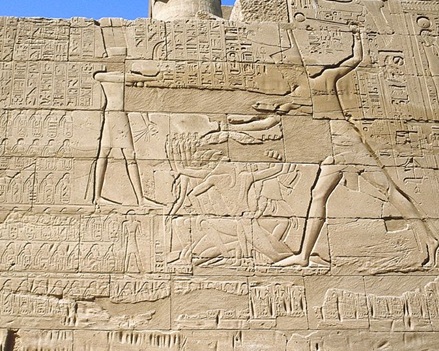
The god Amun (Aurora) handing the khepesh sword to the god king Seti (Mercury) who is in the act in of smiting Egypt’s enemies – wars in the heavens?
I will shortly present what I consider to be irrefutable archaeological evidence in support of my thesis (more specifically, the lack of it) but first allow me to set the scene by taking a look at some of the oddities surrounding the battles of the pharaohs. The following will be brief and I refer you to my book for a more in depth analysis.
Impossible Logistics?
The record shows numerous kings marched north in to Syro-Palestine. How was it possible for 20,000 soldiers to march some 600 miles plus for months on end across the scorching hot Sinai desert, barefoot and wearing nothing more than a loincloth? To keep thousands of men (and animals) fed, watered, clean and free from disease would have required a superhuman feat on a scale bordering on divine intervention. Yet, if the annals are anything to go by, the Egyptians seem to have managed this impossible feat hundreds of times over with military campaigns north-east into Syro-Palestine. Sometimes, as in the case of Tuthmosis III eighteen consecutive campaigns undertaken in Syria in as many years. Some accounts even recall Egyptian troops carrying boats across distant desert lands in order to engage the enemy. How on earth was this done?
Impossible logistics simply disappear when invoking the GKS.
Errant planetary bodies in the guise of divine warrior kings were observed with vast swarms of moons, asteroids and boulders trailing in their wake, these were the legions of foot soldiers dutifully following the king into battle. They were the celestial doubles (souls/kas) of people here on earth – the Egyptians knew them as their kas. (See Egyptian Dualism)
“He shall be at the head of all the kas of the living.”
Thutmose III: The Napata Stela.
Kings and infantry were observed crashing headlong into swarms of enemy space debris to the north, south, east and west, thus perceived to extend the borders of Upper and Lower Egypt, heaven and Earth.
(Tuthmosis/Moon)
“I made the boundaries of Egypt as far as that which the sun encircles. I made strong those who were in fear; I repelled the evil from them. I made Egypt the superior of every land […] favorite of Amun, Son of Re, of his body, his beloved Thutmose I, Shining like Re.”
By way of sacred inscriptions and images the earthly Egyptians honoured their celestial counterparts (kas) by meticulously recording each and every conflict on temple walls.
Tutankhamun (Mars)
“Perfect god, likeness of Re (sun), who appears over foreign lands like the rising of Re, who destroys this land of vile Kush, who shoots his arrows against the enemy.”
They humanised them and gave them the only perspective they could, through that of the natural world. Essentially, we have an ‘as above, so below’ situation. For example; if Egypt’s foes were hundreds miles to the north across the blistering Sinai desert and Pharaonic Mars was observed waging war against space debris above these foreign lands, then, whatever it took to reach this location on earth, it was played out in the annals as such. In other words, what happened above was drawn from the world below; only above, superhuman feats were very much possible.

Planetary god kings riding golden chariots with loyal infantry in tow, traversed the heavens with relative ease, impossible logistics simply disappeared. No watering holes required, no supply route stretching back to Egypt required, no beasts of burden or horses to look after; food just wasn’t a problem. Consequently, hunger, malnutrition and staying free from disease simply disappeared in the divine magical world above. Even the numbers of infantry could be exaggerated i.e. 20,000 or 40,000 infantry traversing above the blistering deserts for months on, defeating the ‘vile Asiatics,’ and returning home in record time becomes completely plausible. This is, of course, from our modern day perspective, to the ancients it was a different story. What they saw were planetary kings, who by their very location were deemed intermediaries between heaven and earth (Upper & Lower Egypt), battling to maintain ‘divine order’ (ma’at) by fearlessly charging into and vanquishing vast swarms of enemy space debris – thus clearing a path to the gods, the ‘next world’ and a life of immortality. The very reason why everything had to go through the Pharaoh. These cosmic wars symbolically represented in the iconic ‘smiting scenes’ carved on numerous temples walls (See the photos on this page).
Leading the army from the front
Pharaohs adopted the most ridiculous battle tactic that any modern day commanding officer would cringe at, that of leading the army from the front.
“The King himself led the way of the army, mighty at its head, like a flame of fire, the king who wrought with his sword.”
Is this possible? Yes, but highly unlikely!
The Pharaoh was Egypt; kings were worshipped as gods, they were intermediaries between heaven and earth, the mortal and the divine. Without the king it was believed the whole cosmos would fall into chaos; without the king there was no Egypt. Despite this fundamental belief Egypt’s kings thought it would be a good idea to risk this godly status and by extension Egypt itself by, not only vacating Egypt for many months, but also potentially setting themselves up to be first in line to die – by leading the army from the front!
Common sense dictates with such beliefs and absurd tactics Egypt’s foes would be guaranteed certain victory by simply killing the king (‘cutting off the head’ springs to mind). A task make easy, in that you’d be blind to miss him; he’s the one leading the charge in a golden chariot, wearing very distinctive attire including a large blue crown adorned with a rearing cobra. I know who I’d be aiming for to bring this battle to a swift end and you certainly wouldn’t need to pin a bulls eye on him.
As mentioned above, planetary bodies in chaos naturally led from the front with vast legions of gravitationally tied asteroids and comets trailing in their wake; planetary bodies were “mighty at the head.” Pharaonic planets led the charge literally “like a flame of fire,” not humans. Such descriptions are clear alluding to celestial bodies. See here for more epithets clearly referring to astral kings. (Image above shows Ramesses dispatching a few foes).
Egypt, 3,000 year of warring; Pharaohs killed in action … none!
Hundreds of wars, battles and border skirmishes over a period of three thousand years and yet no pharaoh ever lost a battle. This, as we have just discussed, despite the fact that they all led from the front.
No Pharaoh ever lost a battle because they were all guises of Mars, Mercury and the Moon and these warrior bodies were no match for the lesser armies of ‘enemy’ asteroids and comets. The celestial warrior kings literally crashed headlong into these and swallowed them up with ruthless efficiency. Although now mere specs of light in the night sky (apart for the Moon), these warriors are still with us and remain undefeated to this day. The surfaces of these planets bear witness to a time when they fought and hoovered up countless tons of ‘evil’ debris that threatened to blot out the sun (Re) and bring the whole world into chaos. The enemy (and ordinary Egyptians) are always depicted smaller than the king because as boulders and space debris they were.
Not a scratch!
Not only were they never defeated all fighting Pharaohs returned home without a scratch. Ramesses the Great, Tuthmosis III (Egypt’s Napoleon) Seti and many other warriors to this very day lie in the Cairo museum showing no signs of engaging in battle. No severed limbs, missing fingers, skin abrasions or battle scared faces (many have been x-rayed). In fact, it is believed (as in the case of Ramesses II and Amenhotep III) they probably died of tooth decay (So much for living gods!). This just doesn’t make sense, how is it possible to lead vast armies from the front, engage the enemy in a bloody battle and return home without a scratch?
Warrior kings reveal no physical sign of battle because these are the earthly representatives of celestial bodies. The true warrior kings were guises of the planets Mars, Mercury and the Moon (GKS). It is with these bodies where we will find the illusive ‘battle’ scars. Take a look at the surfaces of Mars, Mercury and the Moon, they are all pot marked with millions of impact craters. Especially the Moon, the Moon has to be singled out for it has been pummelled by space debris over and over again. It bears the hallmarks of numerous cosmic battles, or as I contend, the pharaonic wars as carved for posterity on numerous temples walls along the Nile.

Why bother to march out and battle at all?
Egypt was one of the richest nations in the ancient world; the Nile’s abundance deemed it the envy of its neighbours. The Egyptians had everything they required to survive and live a comfortable life, so why risk life and limb by marching out across blistering deserts to engage the enemy hundreds of miles away when everything you needed was back home? What was the point? Are we expected to believe the driving force a behind such adventures was a bit of booty? Surely, as an agrarian society, working the fields in order to survive was more important? What of the power vacuum left behind when pharaoh’s army was away for months on end? Tuthmosis III and the Battle of Megiddo takes this king away from Egypt for at least 10 months (Allowing approximately three months to march there and back and the recorded seven month siege). Talk about leaving the back door open! Why not just stay putt and defend the abundant wealth afforded by the Nile?
The afterlife
The Egyptians were obsessed with the afterlife and to be guaranteed a place in the next world it was essential for the deceased to be mummified, an elaborate process involving sacred rituals and typically lasting 70 days. As well as mummification, and again to further ensure a life of immortality it was absolutely imperative for the deceased to be buried on Egyptian soil. Emphasis has to be placed on this fundamental belief; it lay at the bedrock of Egyptian religion, the hundreds of thousands of interred mummies bear testament to this.
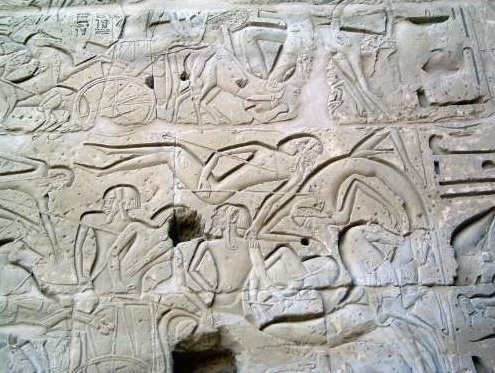
Here we have a serious conundrum, inasmuch, are we expected to believe the Egyptians risked their place in the next world, a life of immortality by undertaking arduous military campaigns hundreds of miles away across deadly terrain? What if they died en route? What of the thousands of soldiers killed in action? Where are they? Were they interred on foreign lands? This is not possible, in that it goes against the fundamental conviction that if you were not embalmed and buried in Egypt, then you were not eligible for a life of immortality in the hereafter. I cannot stress this point enough; to be buried outside Egypt deemed immortality absolutely null and void!
But are we then expected to believe hundreds of rotting corpses were transported back to Egypt some 600 miles across dry arid scorching hot deserts? Even to the uninitiated, this not only doesn’t make sense, in ancient times it has to be impossible.
“Little is known about how the Egyptians prepared themselves for dealing with expected casualties…” (Ref)
It is my contention the Egyptians rarely strayed from the relative safety of the Nile Valley, certainly not vast armies of men with the king at the head marching across distant lands, there was no impending need. Sure, they carried out trading and mining expeditions beyond Egypt’s borders and there is no doubt they mined for certain coloured rock (black granite) and turquoise in the Sinai. They also undoubtedly explored as far as they dared, or as conditions and the climate allowed them to, including following the Nile (safe) south, deep into Nubian territory (pretty normal behaviour really).
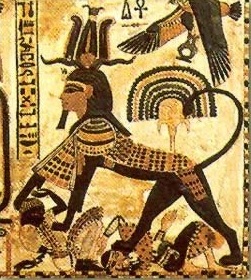
Furthermore, in veneration of the ‘sacred’ battles fought by the celestial god kings they sent out small groups to mark the astral location (as near as possible) by carving honorary victory stela (carved stone), recounting the bravery and incredible deeds undertaken by their celestial counterparts. There is evidence to suggest this occurred on a number of occasions, given the GKS isn’t this just as you would expect?
But all of the above expeditions involved small numbers; small self-surviving groups who could negotiate inhospitable terrain, accomplish their mission and return to the relative safety of the Nile. It certainly did not involve thousands of troops marching out across deadly terrain with the king at the helm. If such distant campaigns were undertaken, you would think, at the very least, and to save marching out again and again to the same place the Egyptians would leave behind a controlling army or garrison – alas, even this was not done. This is because planetary bodies rarely remained stationary in the heavens, if they did, this was seen as a siege (Image above: symbolic repsentation of wars in the heavens)
Irrefutable evidence
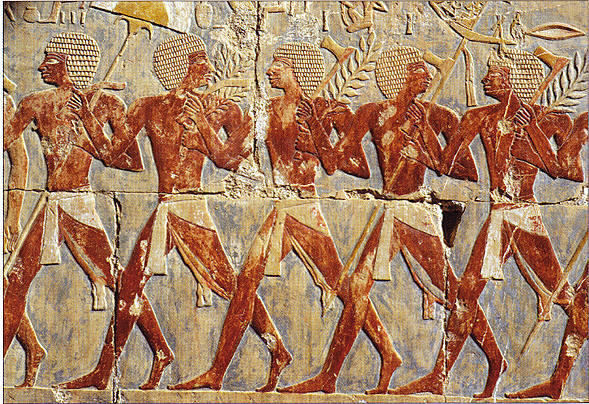
We will now turn our attention to what I consider overwhelming evidence in support of the GKS – the archaeological evidence, more specifically the lack of it. Inasmuch, in the face of the many hundreds of military expeditions carried out by the pharaohs archaeologists have been unable to verify ANY of the events recounted in Egyptian records. This situation exists even though the location of many of Egypt’s conflicts are known. We would expect to find the remains of swords, arrow heads, battle axes, chariot parts, amour, and more importantly battle-scarred human remains or mass graves. However, there is a distinct lack of archaeological evidence and no data to support the existence of ancient battlefields. Upon close scrutiny, it becomes very obvious that the wars and battles of the kings exist in ‘sacred’ words alone – no archaeological evidence exists for them as ever having taken place. That is of course, unless we look up and take into account the GKS.
We will consider briefly one of the best documented battles of the ancient world, Ramesses II and the Battle of Kadesh. We have more accounts of this battle than any other from ancient times. It was carved on numerous temple walls. History states that Ramesses led 20,000 infantry into Syro-Palestine and fearlessly fought and defeated 40,000 Hittites (according to Egyptian inscriptions). Detailed maps exist which show the exact location of Kadesh near the Orontes River in Syria. They include diagrams, complete with arrows, which show how the battle was played out. Modern photographs and details of Kadesh can be found here.
However, despite an abundance of information it seems the Battle of Kadesh existed in sacred words only as the exact location of Kadesh has yet to be found – there is no archaeological evidence revealing its location and if any battles took place there. I find it perplexing that so many books and TV documentaries cover ‘The Battle of Kadesh’ and yet none are backed up by archaeological evidence.
Moreover, the record shows Kadesh was the site of many military campaigns. Many pharaohs before and after Ramesses fought bloody battles there; these wars totaled many hundreds of thousands of men i.e. Ramesses II’s army of 20,000 soldiers plus 40,000 Hittites totaled 60,000 men alone. Yet it seems they left nothing behind. There isn’t a museum in the world that houses battle implements or killed in action soldiers which can irrefutably linked to any battles fought at Kadesh.
A prediction; the location of Kadesh will never be found unless people begin to look up and take into account the GKS.
Some may say absence of evidence is not proof enough and believe that we’re just not looking in the right place and one day battle strewn Kadesh will be found. Although unlikely given the scope and information available, it is possible. So let us turn our attention to the scene of many a major battle and a location where archaeologists have been excavating for years.
Megiddo (Armageddon)
Megiddo is one of the most fabled and fought over pieces of real estates in the ancient world; at least 34 battles are known to have taken place here (the majority involving the Egyptians). Eighteen consecutive campaigns attributed to Tuthmosis III (Egypt’s Napoleon) alone and yet no corroboratory archaeological evidence exists.
Thutmose III: The Battle of Megiddo (Relevant links: Here, here and here)
To put this into some kind of context, Megiddo is an location where hundreds of thousands of soldiers engaged in numerous battles over a period of 3,000 years i.e. thousands of chariots, battle axes, spears, bows and arrows, the carnage, dead soldiers, etc. etc. and yet no archaeological evidence remains to corroborate them as ever taking place – nothing. We have an abundance of written documentation but – NO CRIME SCENE! This is despite the fact that archaeologists have been digging there for decades.
I wrote to N Franlin the coordinator of the Megiddo expedition (Tel Aviv University) and politely asked “where’s the archaeological evidence for any of the battles fought by the Pharaohs at Megiddo?” In the absence of ANY evidence whatsoever, this is the reply I received.
Chariot parts
“Chariots were made mainly of wood and leather. Neither medium survives for long. Metal parts were small and were either collected and re-used or deteriorated. Ceremonial chariots e.g. Tutmose’s chariot would have had gold decoration — those chariots were collected as booty and also re-used/re-cycled.”
Weapons
“Always collected and re-used. Nothing went to waste. They were better at recycling than we are in the modern world!”
Dead bodies on the battlefield.
a) They are either left and deteriorate quickly in the rather acid based limestone derived soil prevalent in the area. If anything ever survives it is often a lone tooth!
b) Bodies are retrieved by the army that sent those soldiers if the victor and buried.
c) Bodies are retrieved by the opposing army if the victor and displayed and/or mutilated to show how strong the victor is.
With the greatest respect to N Franklin, the answers provided above make absolutely no sense at all. Common sense deems the whole thing is impossible and nonsensical. How can 34 major battles involving hundreds of thousands of soldiers spanning some 3,000 years completely disappear off the face of the Earth? If it is known that the ancients “… were better at recyling than we are in the modern world!” then, what’s the point in digging then? It was even found that Megiddo wasn’t even fortified! How can this be when the pharaoh Tuthmosis III was supposed to have laid siege to the city for 7 months?
To prove that the Egyptians were not “better at recycling than we are in the modern world” we only need visit the site of Ramesses’ II ancient city, Per-Ramesses (modern day Qantir).
Recent excavations here revealed amongst other items hundreds of broken stone carved ‘knobs.’ These were later identified as chariots parts, they form part of the harness and can be seen on the ceremonial chariots of Tutankhamun in the Cairo Museum. The chariot parts were not difficult to find, they were found just below the surface and surprisingly within just three days of digging (Source; M Bietak. Documentary Lost City of the Ancients). Although most were in bits many intact ‘knobs’ were also found. They even unearthed a complete horses bit, to date the only one of its kind.
Point to consider;
How difficult was it to pick these artefacts up? To my knowledge they were found around the location of stables (as you would expect). Nowhere near the mayhem of battle – it is with ease these parts could be collected. They were not; they were left where they fell because as broken stone parts they were useless, impossible to recycle. All things normal, it is this sort of artefact and other similar items associated with battle that should be strewn about all over the site of Megiddo ; there should be loads of battle artefacts. As we have seen there are none. What of the fully working ‘knobs’ and the horses bit? I thought the ancient were super efficient at recycling? The finds at Per Ramesses proves that this was not so.
These finds merely show us show the Egyptians were pretty much the same as us when it came to recycling. Broken parts of machinery were simply discarded with complete working parts occasionally getting lost or mislaid. This would include the occasional horses’ bits, although none, it seems, at Megiddo!
“Re (Sun) himself established me, I was dignified with the diadems which were upon his head, his serpent-diadem, rested upon “my forehead he satisfied me with all his glories; I was sated with the counsels of the gods, like Horus, when he counted his body at the house of my father, Amun. I was presented with the dignities of a god, with […] my diadems.” (Breasted)


